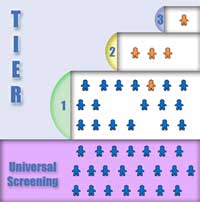RTI (Part 1): An Overview
Wrap Up
Response to Intervention, or RTI, has the potential to improve the education of struggling readers. When used to provide early intervening services, RTI:
- Ensures that all students receive high-quality instruction in the general education classroom
- Promotes immediate intervention as soon as students’ reading problems are revealed
- Curtails the development of substantial reading difficulties
- Reduces inappropriate referrals for and placements in special education
 When used as an alternative to the IQ-achievement discrepancy model for identifying students with learning disabilities, RTI:
When used as an alternative to the IQ-achievement discrepancy model for identifying students with learning disabilities, RTI:
- Ensures that struggling readers have received high-quality instruction before referrals to special education are made
- Uses classroom data, rather than subjective observations, to make decisions about whether students should be referred for an evaluation for special education services
- Delivers services as soon as students begin to struggle
Click on the movie below to hear Doug Fuchs review the basic process used to implement an RTI approach (time: 2:07).
Transcript: Wrap Up
A typical RTI procedure begins with the identification of an at-risk group. It might be that all children in a given class or school are tested in the fall with some screening measure. It may be that the children are identified by last year’s achievement test scores. There are different ways of doing this, but an at-risk group should be identified so that the focus of attention is on a relatively small number of kids and not everybody. Then the classroom teacher has the correct professional development to implement a research-validated reading program, in response to which we would expect most kids to show academic growth. During the implementation, the at-risk group is monitored with a valid method of assessment. Children within the at-risk group who do not respond sufficiently to that research-validated instruction in the regular classroom receive another tier of instruction, which is even more intensive. The instruction is more intensive because it may be delivered in small groups, because it may meet more often, because it may be taught or supervised by someone with greater expertise in the content area than the general education teacher. However it’s defined, the instruction at the second tier is more intensive than the instruction in the first tier, and in that second tier, again, the children are monitored. The students who make adequate progress no longer need the additional Tier 2 instruction. Presumably, they now are ready to pick up where they left off and show good progress. The students who continue to struggle, whose responsiveness is less than desired then-depending on the model-go to a third tier, even more intensive than the second, or they go to a multidisciplinary team for a formal evaluation.
Revisiting Initial Thoughts
Think back to your initial responses to the following questions. After working through the resources in this module, do you still agree with your Initial Thoughts? If not, what aspects of your answers would you change?
What procedures do you think Rosa Parks Elementary is using to provide services to struggling students? Why are school personnel dissatisfied with this process?
What approaches are available to schools to help struggling readers and to efficiently identify students who need special education services?
What other information might a school find helpful when choosing which approach to adopt?
What steps might the S-Team propose to help its struggling readers?
When you are ready, proceed to the Assessment section.